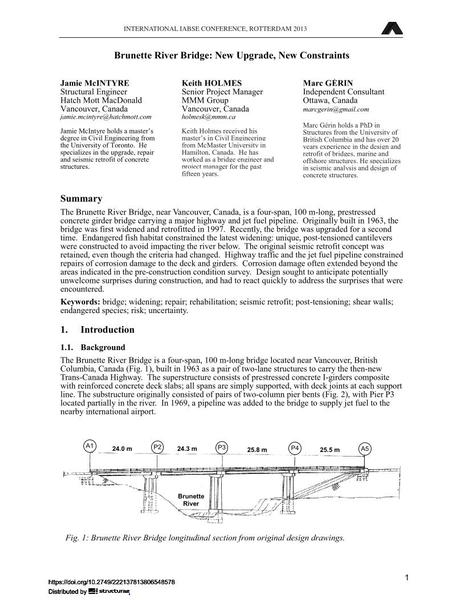Brunette River Bridge: New Upgrade, New Constraints

|
|
|||||||||||
Détails bibliographiques
| Auteur(s): |
Jamie McIntyre
Keith Holmes Marc Gérin |
||||
|---|---|---|---|---|---|
| Médium: | papier de conférence | ||||
| Langue(s): | anglais | ||||
| Conférence: | IABSE Conference: Assessment, Upgrading and Refurbishment of Infrastructures, Rotterdam, The Netherlands, 6-8 May 2013 | ||||
| Publié dans: | IABSE Conference, Rotterdam, May 2013 | ||||
|
|||||
| Page(s): | 610-611 | ||||
| Nombre total de pages (du PDF): | 8 | ||||
| Année: | 2013 | ||||
| DOI: | 10.2749/222137813806548578 | ||||
| Abstrait: |
The Brunette River Bridge, near Vancouver, Canada, is a four-span, 100 m-long, prestressed concrete girder bridge carrying a major highway and jet fuel pipeline. Originally built in 1963, the bridge was first widened and retrofitted in 1997. Recently, the bridge was upgraded for a second time. Endangered fish habitat constrained the latest widening: unique, post-tensioned cantilevers were constructed to avoid impacting the river below. The original seismic retrofit concept was retained, even though the criteria had changed. Highway traffic and the jet fuel pipeline constrained repairs of corrosion damage to the deck and girders. Corrosion damage often extended beyond the areas indicated in the pre-construction condition survey. Design sought to anticipate potentially unwelcome surprises during construction, and had to react quickly to address the surprises that were encountered. |
||||
| Mots-clé: |
pont élargissement risque reconception pour effets sismiques
|
||||
